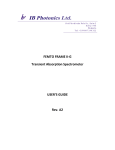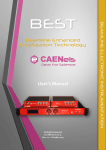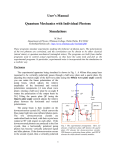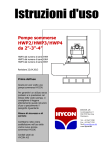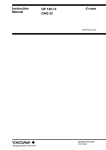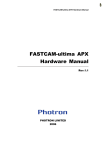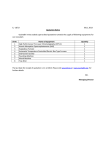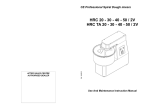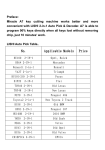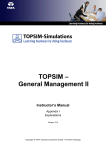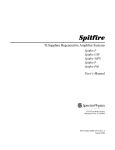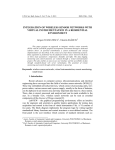Download FLUOMAX-SC Fluorescence Upconversion
Transcript
1 9 A P lo v d iv sk o P o le S t., S u ite 2 S o f ia 1 7 5 6 B u lg ar ia T el: + 3 5 9 8 8 7 3 3 0 3 2 2 FLUOMAX-SC Fluorescence Upconversion Spectrometer USER’S GUIDE Rev. A3 IBPhotonics Ltd. FluoMax-SC User’s Guide TABLE OF CONTENTS 1. Warranty Information ................................................................................................................. 3 1. Safety Precautions ....................................................................................................................... 4 1.1 General Warnings ........................................................................................................................ 4 1.2 General Cautions ......................................................................................................................... 4 1.3 Laser Safety ................................................................................................................................. 4 2. PUMP REQUIREMENTS ........................................................................................................................ 7 3. BASICS OF OPERATION ........................................................................................................................ 8 5. INITIAL INSTALATION ......................................................................................................................... 11 5.1. POSITIONING AND CONNECTING OF FLUOMAX ........................................................................ 11 5.2. CONNECTING THE BOXES ........................................................................................................... 11 5.3. MOUNTING OF THE OF THE OPTICS ........................................................................................... 12 5.3.1. Alignment of the beams outside FluoMax .......................................................................... 12 5.3.2. Alignment of the Second Harmonic Generator ................................................................... 12 5.3.3. Alignment of the Optical Delay ........................................................................................... 14 5.3.4. Alignment of the Sample excitation beam .......................................................................... 17 5.3.5. Alignment of the Sum-Frequency Generation Crystal ........................................................ 20 5.3.6. Alignment of the Monochromator ...................................................................................... 21 6. SOFTWARE......................................................................................................................................... 23 6.1. Software Installation .................................................................................................................. 23 6.2. Control Utility Description .......................................................................................................... 23 6.2.1. Welcome panel and translation stage COM port setting .................................................... 24 6.2.1. Alignment Page.................................................................................................................... 25 6.2.3. Configure Delay Line panel .................................................................................................. 27 6.2.5 Parameters Page................................................................................................................... 28 6.2.5 Measurement Page .............................................................................................................. 31 6.2.7. Exit Page .............................................................................................................................. 32 7. DAY-TO-DAY OPERATION .................................................................................................................. 33 7.1. Powering Up the Spectrometer.................................................................................................. 33 7.2. Second Harmonic Generator beam check and alignment .................................................... 33 7.3. Gate beam check-up.............................................................................................................. 34 7.4. Excitation beam check-up and alignment. ............................................................................ 35 7.5. Fluorescence collecting optics check-up and alignment ....................................................... 36 7.6. Alignment of SFG and relay optics, signal optimization ........................................................ 36 Rev.A3 Page 1 of 41 IBPhotonics Ltd. FluoMax-SC User’s Guide 7.7. Switching Between transmission and reflection Mode of operation ................................... 37 7.8. Output data file structure ..................................................................................................... 38 LIST OF FIGURES Figure 1. Schematic diagram of upconversion. ....................................................................................... 8 Figure 2. FluoMax-SC optical scheme...................................................................................................... 9 Figure 3. Electric block-diagram of FluoMax-SC. ................................................................................... 11 Figure 4. FluoMax-SC opto-mechanical layout. .................................................................................... 13 Figure 5. Positions of the beam spots onto the Retro Reflector. .......................................................... 15 Figure 6. Page selection tabs. ................................................................................................................ 23 Figure 7. A view of the welcome screen. .............................................................................................. 24 Figure 8. Set COM port panel. ............................................................................................................... 24 Figure 9. Screenshot of the Alignment page. ........................................................................................ 25 Figure 10. Optical delay line configuration panel ................................................................................. 27 Figure 11. Parameters page .................................................................................................................. 28 Figure 12. Overview of the Measurement page ................................................................................... 31 Rev.A3 Page 2 of 41 IBPhotonics Ltd. FluoMax-SC User’s Guide 1. Warranty Information IBPhotonics warrants that this product will be free from defects in material and workmanship and will comply with IBPhotonics’ published specifications at the time of sale for a period of one and a half years from date of commissioning of the instrument. If the product is found to be defective during the warranty period, the product will either be repaired or replaced at IBPhotonics’ option. To exercise this warranty, write or call your local IBPhotonics representative, or contact IBPhotonics headquarters in Sofia, Bulgaria. You will be given prompt assistance and, if necessary, return instructions. Send the product, freight prepaid, to the indicated service facility. Repairs will be made and the instrument shall be returned freight prepaid. Repaired products are warranted for the remainder of the original warranty period or 90 days, whichever first occurs. Limitation of Warranty The above warranties do not apply to products which have been repaired or modified without IBPhotonics’ written approval, or products subjected to unusual physical, thermal or electrical stress, improper installation, misuse, abuse, accident or negligence in use, storage, transportation or handling. This warranty also does not apply to fuses, batteries, or damage from battery leakage. THIS WARRANTY IS IN LIEU OF ALL OTHER WARRANTIES, EXPRESSED OR IMPLIED, INCLUDING ANY IMPLIED WARRANTY OF MERCHANTABILITY OR FITNESS FOR A PARTICULAR USE. IBPHOTONICS SHALL NOT BE LIABLE FOR ANY INDIRECT, SPECIAL, OR CONSEQUENTIAL DAMAGES RESULTING FROM THE PURCHASE OR USE OF ITS PRODUCTS. © 2008-2014 IBPhotonics Ltd., Sofia, Bulgaria. All rights reserved. This manual has been provided for information only and product specifications are subject to change without notice. Any change will be reflected in future printings. IBPHOTONICS LTD. 19A Plovdivsko Pole Street, Suite #2 1756 Sofia, Bulgaria www.ibphotonics.com Rev.A3 Page 3 of 41 IBPhotonics Ltd. FluoMax-SC User’s Guide 1. Safety Precautions 1.1 General Warnings Observe these general warnings when operating or servicing this equipment: Heed all warnings on the unit and in the operating instructions. Do not use this equipment in or near water. This equipment is grounded through the grounding conductor of the power cord. Route power cords and other cables so they are not likely to be damaged. Disconnect power before cleaning the equipment. Lockout all electrical power sources before servicing the equipment. To avoid fire hazard, use only the specified fuse(s) with the correct type number, voltage and current ratings as referenced in the appropriate locations in the service instructions or on the equipment. Only qualified service personnel should replace fuses. Qualified service personnel should perform safety checks after any service. 1.2 General Cautions Observe these cautions when operating or servicing the equipment: If the equipment is used in a manner not specified in this manual, the protection provided for the equipment may be impaired. To prevent damage to any of the equipment when replacing fuses, locate and correct the problem that caused the fuse to blow before re-applying power. Do not block ventilation openings of any instrument. Use only the specified replacement parts. Follow precautions for static sensitive devices when handling electronic equipment. To prevent damage to the equipment read the instructions in the equipment manual for proper input voltage. Adhere to good laser safety practices when using the equipment. 1.3 Laser Safety The FluoMax spectrometer is not a laser source itself. However it works with laser sources classified under regulations established by the Center for Devices and Radiological Health (CDRH), USA of the Food and Drug Administration-USA, as a Class IV laser products. Precautions for working with Class IV High Power Lasers: • Follow strictly all safety precautions provided in the laser source manual. Rev.A3 Page 4 of 41 IBPhotonics Ltd. • FluoMax-SC User’s Guide Wear laser protection eyewear at all times. Eyewear must be appropriate for the generated wavelength and beam intensity. If you are not sure what eyewear is appropriate, consult your organization’s Laser Safety Officer. • Install the laser equipment in an enclosed and controlled access area. Limit access to this area to trained users who are familiar with the principles and practices of laser safety. • Post highly visible warning signs near the laser operation area, such as the following: • Maintain a brightly lit laser operation area. This constricts the eye’s pupil, reducing the possibility of eye damage. • Experiment setups should be above or below eye level for any standing or seated position in the laser operation area. • Keep the protective cover on the laser at all times. • Do not look at the beams; even diffuse reflections are hazardous. • While using the instrument, do not wear objects (such as jewelry) that may reflect or scatter the beam. • Before working in front of the laser, verify that the laser beam is off. • Avoid blocking the output beam or its reflection with any part of your body. • When possible, create enclosures for beam paths and set up shields to prevent specular reflections. • Set up an energy-absorbing target to capture the laser beam, preventing unnecessary reflections or scattering. The FluoMax spectrometer operates with coherent radiation in visible and invisible to human eye (infrared and ultraviolet) spectral regions generated from Class IV laser products. The greatest concern when using FluoMax is eye safety. Direct, reflected or scattered radiation present in FluoMax can cause permanent eye damage. Apart from that, the Rev.A3 Page 5 of 41 IBPhotonics Ltd. FluoMax-SC User’s Guide radiation present in FluoMax can also cause skin or clothing burn, or ignite fire if hitting flammable substances. Because of these reasons the user is advised to follow the measures listed below: 1. This device and supplementary equipment must be located in a locked area with access to authorized personnel only. This area must be marked by well defined warning signs, and be off limits to everyone except authorization personnel. 2. FluoMax must only be operated by qualified personnel who have been trained by IBPhotonics customer-service engineer. 3. Block the input beams before opening the cover. Make sure all optical components inside FluoMax are orientated according to Fig. 3 before unblocking the path of the beams. Intense light beams, their specular and scattered reflections can be emitted from various parts of FluoMax when the cover is opened! 4. Maintain FluoMax and all connected experimental setups considerably bellow eye level to prevent accidental beam encounter. Keep the beams enclosed where possible. 5. Avoid viewing beams and specular reflections. Use protective eyewear at all times when aligning and operating FluoMax. Make sure that your protective glasses cover the tuning range of lasers used with FluoMax! Remember that the protective glasses, while protecting your eyes, also prevent from seeing the beams. Therefore be cautious even when using safety glasses. 6. Observe all other safety precautions given in the user’s manual. The used power/ pulse energy inside FluoMax may vary upon the type of pump laser used. The average input power may exceed 2.5 W, with pulse duration ranging from 20 to 150 fs and hundreds of nanojoules of pump energy. Be very careful when aligning and working with FluoMax. Rev.A3 Page 6 of 41 IBPhotonics Ltd. FluoMax-SC User’s Guide 2. PUMP REQUIREMENTS Good performance of FluoMax requires high pump quality in terms of both time and space coherence. Therefore that ideal pump is diffraction-limited laser beam, with transform-limited pulses and high pulse contrast. Unlike with conventional lasers with coherent pump, the phase modulation of pump pulse and/or beam inevitably influences the output results. To great extend, performance of FluoMax depends on the quality of the pump laser radiation. Spatial beam quality. Non-uniformity of the beam reduces the energy conversion rate. Presence of hot spots in the beam may “ignite” small-scale self-focusing that in turn leads to phase modulation. Spatial/temporal beam distortion. In contrast to long pulse lasers, astigmatism introduced by improperly aligned lenses of beam expanders/reducers lead to distortion of temporal profile of the pulse across the beam. This changes the properties of the spots on the sample and sum-frequency crystal inside FluoMax and the temporal resolution of the spectrometer. Tilted pulses. This phenomenon manifests itself in similar way as that discussed above. It can originate from improper pulse compressor alignment. Tilted pulses are produced when the angular dispersion is not completely cancelled. The problem with this kind of distortion is that it can be easily overlooked using standard diagnostics equipment such as autocorrelator. Feedback to pumping oscillator. Reflections coming backward from FluoMax may cause interference with pumping oscillators. When aligning FluoMax take care, that any reflection from the optical elements is not coming backward along the pump beam. Pump Source Parameters: Output Power: > 700 mW Pulsewidth: 40 – 200 fs Beam Diameter: 4 - 8 mm (near TEM00) Polarization: Linear Repetition rate: 1-100 MHz Wavelength: 780 – 900 nm Rev.A3 Page 7 of 41 IBPhotonics Ltd. FluoMax-SC User’s Guide 3. BASICS OF OPERATION Fluorescence upconversion (also called sum frequency generation) is a nonlinear technique that involves frequency mixing. In this method, the fluorescence excited by an ultrafast laser pulse is mixed with another (delayed) portion of the laser pulse in a nonlinear optical crystal such as BBO to generate sum-frequency radiation. Since this mixing process takes place only during the presence of the second laser pulse, it provides time resolution comparable to the pulse width; delaying the gate pulses with a mechanical stage leads to an “optical boxcar approach.” By changing the angle of the incident gate beam and fluorescence beams with respect to the optical axis in the crystal, the phase-matching conditions c changed to select a different fluorescence wavelength for upconversion. The time resolution mechanism underlying the upconversion technique is illustrated in Fig. 8.1. Upconversion is actually a cross-correlation between the fluorescence and the “gate” laser pulse. At time t = 0, the sample is electronically excited by, for example, the second or third harmonic of an ultrafast laser pulse with frequency ωp. Figure 1. Schematic diagram of upconversion. The collected incoherent fluorescence (ωF) and the probe laser pulse (ωp) arriving at time t = τ are co-focused into a nonlinear optical crystal (BBO) which is oriented at an appropriate angle with respect to the fluorescence and laser beams. Sum frequency photons are generated only during the time that the probe laser pulse is present in the crystal, acting as a “light gate,” and thus time resolution is within the laser pulse width. The time evolution of fluorescence may then be traced by varying the delay τ of the probe laser beam. An analysis of sum frequency generation shows the intensity of the sum frequency signal at a Rev.A3 Page 8 of 41 IBPhotonics Ltd. FluoMax-SC User’s Guide given delay time ω is proportional to the correlation function of the fluorescence intensity with the probe laser intensity. HWP 1 L1 M2 L2 SHG M1 DM 1 M4 L3 M3 L5 M6 M8 Retro Refl. M7 M5 HWP3 M10 PM 1 LPF L6 Sample M17 M9 SPF M13 HWP 2 M19 M16 L7 NDF1 M14 L4 M15 M12 SFG M11 Monochromator PMT PM 2 M13 F2 Figure 2. FluoMax-SC optical scheme The beam from the pump laser (at 800 nm) enters FluoMax-SC main optical unit through the optical port W1. After passing the (optional) telescope formed by LA and LB, the beam is focused on to the Second harmonic generation crystal SHG by the concave mirror M1. The polarization of the input beam is compensated to vertical by using an (optional) Half-wave plate HWP1. Divergence of the beam after the SHG is compensated by the collimating Mirror M2. After folding of the beam by mirror M3, it strikes the dichroic Beamsplitter DM1, which reflects the second harmonic beam towards the lens L5. The fundamental frequency beam passes though the DM1 and is reflected by mirrors M4 and M5 to the RetroReflector. Reflected beam after the first pass is folded back by mirrors M6 and M7 towards the reflector. Delayed pulses in the fundamental beam are further steered to the focusing lens L4 by the mirrors M8, M9 and M10. A residual polarization change is compensated by the (optional) Half-wave plate HWP3. Focusing of the gate beam into the Rev.A3 Page 9 of 41 IBPhotonics Ltd. FluoMax-SC User’s Guide SFG is achieved by lens L4 and correction of the overlap with the fluorescence beam in SFG crystal is achieved with the steering mirror M11. On the other hand, the second-harmonic beam passed though DM1 is reflected by M4 towards the collimating lens L5. As next step, short-pass filter SPF and the halfwaveplate HWP2 are applied to suppress the residual fundamental frequency component in the excitation beam and to control the excitation polarization. The beam is further directed to the neutral density filter NDF1 that is used to control the incident power on the sample. When the flip mirror M16 is in upright position, it reflects the excitation beam towards the sample for measurement in transmission (forward) configuration. The deflected beam form M16 and M17 is focused on the sample by the lens L6. In the reflection (backward) configuration, flip mirror is switched down and beam is focused by the lens L7. Mirrors M18 and M19 are used to direct the excitation beam towards the sample. Fluorescence from the sample is collected and collimated by the parabolic mirror PM1 and is re-imaged onto the SFG crystal by the parabola mirror PM2 for mixing with the fundamental beam. The sum-frequency generated light is collimated by the concave mirror M12 and refocused on the input slit of the monochromator by the M13. Additional filter F2 can be used in front of the monochromator in order to eliminate the residual portion of the excitation beam that is transmitted/reflected by the sample. Iris diaphragms D1 trough D8 are used as aid for optical alignment of the corresponding beams. During the measurement, all diaphragms should be in maximally opened position to avoid clipping of the beams. Rev.A3 Page 10 of 41 IBPhotonics Ltd. FluoMax-SC User’s Guide 5. INITIAL INSTALATION 5.1. POSITIONING AND CONNECTING OF FLUOMAX Take the FluoMax main optical unit of the delivery crate. Position the instrument along one side of optical table about 5-6 cm from the table edge. Such positioning allows convenient access while operating or aligning the device. Use the four clamps to attach FluoMax stable on standard optical table. FluoMax can accept the maximum beam size of 8 mm (1/e2). An additional external telescope before FluoMax is needed with larger pump beam size at FluoMax optical input. It is important that the beam would not clip on any aperture before FluoMax and inside of it in order to achieve good output results. 5.2. CONNECTING THE BOXES AC/DC 12V Tr. Stage Controller 110VAC Tr.Stage TR. STAGE 110VAC Rs232 Rs232 Rot.Stage PC Rs232 USB Mono Power AC/DC 24V 110VAC Signal MONO PMT Power Adapter Module ROT.STAGE Pulse Counter Board AC/DC 15V 110VAC Figure 3. Electric block-diagram of FluoMax-SC. Take the PC, monitor and keyboard out of the delivery boxes. Place them near FluoMax at a convenient location. Remove also the digital controller box from the packaging and place it near the main optical unit at a convenient location. Connect the composite power cable of the main unit to the controller box. Connect the data/ control cables to the main unit panel and the computer. Connect the coaxial signal cable between the main unit and the controller box. Rev.A3 Page 11 of 41 IBPhotonics Ltd. FluoMax-SC User’s Guide Connect the power lines of the computer, monitor and the controller to a suitable power splitter. Power up the computer and log on. Power up the digital controller. Start the originally installed software and test whether the modules work according their specification. If any component gives a malfunction please contact immediately the technical representative of IBPhotonics. 5.3. MOUNTING OF THE OF THE OPTICS Through this chapter please refer to the FluoMax layout Figure 3 below. FluoMax is delivered to the customers with the optics removed and packed separately for safety issues. Nevertheless, every single FluoMax spectrometer is previously tested and the mechanical components are positioned and orientated according Fig. 3. Before starting to mount the optics in their positions, please check whether the mechanical holders and components are correctly oriented. 5.3.1. Alignment of the beams outside FluoMax The pump beam from the laser should enter FluoMax through the geometric center of W1. Use two iris diaphragms at height 150 mm and two mirrors in kinematic holders to properly adjust and direct the probing beam into W1. When aligning the beams outside FluoMax make sure they are not clipped by the used optics and diaphragms. 5.3.2. Alignment of the Second Harmonic Generator Block the path of the beam. Place the iris diaphragm D1 exactly at height 120 mm above the main breadboard of FluoMax-MP and with its geometric center exactly above the grid. Fix D. Using the kinematic mirror holders outside FluoMax-MP make sure the beam passes through the geometric center of D1 and is not clipped. Block the path of the beam that enters FluoMax-MP. Place the lens L1 so that its geometric center is approximately at height 110 mm above the grid and the beam passes through it. The pump beam after passing through D1 should strike L1 at its center. Fix the lens. Rev.A3 Page 12 of 41 IBPhotonics Ltd. FluoMax-SC User’s Guide Ma Mb HWP 1 L1 L2 D1 M2 SHG M1 M4 D2 DM 1 M3 W1 L3 M6 Retro Refl. M7 M10 D4 LPF PM 1 M13 M19 M5 HWP3 Sample D6 D7 M9 L6 D3 M17 SPF HWP 2 D8 M16 L7 M18 M8 L5 L4 M14 M15 NDF1 D5 SFG M12 Monochromator PMT M11 M13 PM 2 F2 Figure 4. FluoMax-SC opto-mechanical layout. Block the path of the beam. Place the lens L2 in such a way that its geometric center is approximately at height 110 mm above the grid and the beam passes through it. Use the translation stage beneath the lens holder of L2 and a white card to observe the beam spot to make sure the beam after L2 is collimated. The pump beam after passing through L2 should strike D2 at its geometric center and passes through it without clipping. Fix the lens. Block the path of the beam after D1. Place the spherical mirror M1 so that its geometric center is approximately at height 120 mm above the grid. M1 should be orientated in such a way that after reflecting from it the beam should be propagating towards M2. Unblock the beam and adjust M1 so that the beam strikes it approximately at its geometric center. Fix M1. Rev.A3 Page 13 of 41 IBPhotonics Ltd. FluoMax-SC User’s Guide Block the path of the beam after M1. Place the spherical mirror M2 so that its geometric center is approximately at height 110 mm above the grid. M2 should be orientated in such a way that after reflecting from it the beam should be collimated and propagating towards the iris diaphragm D2. Unblock the beam and using the kinematic holder of M1 make sure the beam strikes M2 approximately at its geometric center. If properly adjusted M2 should be in such position that the beam propagating between D1 and M1 passes as close to M2 as possible, without clipping. Fix M2. Block the path of the beam after M2. Place the iris diaphragm D2 exactly at height 110 mm above the main breadboard of FluoMax and with its geometric center exactly above the grid. Using the kinematic mirror holder of M2 make sure the beam passes through the geometric center of D2 and is not clipped. If properly adjusted D2 should be in such position that the beam propagating between M2 and D2 passes as close to M1 as possible, without clipping. Fix D2. Block the path of the beam after D1. Place the Second Harmonic Generation crystal – SHG approximately at height 110 mm above the main breadboard of FluoMax-MP. Unblock the path of the beam and adjust SHG so that the beam passes approximately through its geometric center. SHG should be adjusted in such a way that after passing through it the beam should still pass through the geometric center of D2 and is not clipped. Fix SHG. 5.3.3. Alignment of the Optical Delay Block the path of the beam after D2. Place the flat mirror M3 approximately at height 110 mm above the main breadboard of FluoMax. Unblock the beam and adjust M3 so that the beam approximately strikes its geometric center. M3 should be orientated so that after reflection from it the beam is propagating towards M4. Fix M3. Block the path of the beam reflected from M3. Place the flat mirror M4 approximately at height 110 mm above the main breadboard of FluoMax. M4 is orientated so that it reflects the fundamental wavelenght towards M5. Using the kinematic mirror holder of M3 make sure the beam strikes M4 approximately at its geometric center. Block the path of the beam reflected from M4. Place the lens L3 approximately at height 110 mm above the main breadboard of FluoMax. Unblock the path of the beam and using the kinematic mirror holder of M4 make sure the beam strikes L3 at its geometric Rev.A3 Page 14 of 41 IBPhotonics Ltd. FluoMax--SC User’s Guide center. Observe the profile beam that passes through L3 by a white card. It should have a circular cross-section. Fix L3. Block the path of the beam reflected from M4. Place the flat mirror M5 approximately at height 110 mm above the main breadboard of FluoMax. M5 should be orientated so that it reflects the beam towards the Retro Reflector. Unblock the path of the beam and adjust M5 so that the beam is not clipped by its aperture. Fix M5. Figure 5.. Positions of the beam spots onto the Retro Reflector. Ref The reflected by M5 beam should strikes the Retro Reflector as shown on Figure 7 in position 1. The beam comes from the Retro Reflector from position 2. Block the path of the beam reflected from the Retro Reflector from position 2. Place mirror M6 approximately at height 70 mm above the main breadboard of FluoMax. M6 should be orientated so that after reflection from it the beam propagates towards M7. Unblock the path of the beam and adjust M6 so that the beam is not clipped by its aperture. Fix M6. Block the path of the beam reflected from M6. Place mirror M7 approximately at height 70 mm above the main breadboard of FluoMax. M7 should be orientated so that after reflection from it the beam propagates towards the Retro Reflector. Unblock the path off the beam and using the kinematic mirror holder of M7 adjust the beam so that it hits M7 without clipping. Fix M7. Rev.A3 Page 15 of 41 IBPhotonics Ltd. FluoMax-SC User’s Guide If properly adjusted the beam reflected from M7 should strike the Retro Reflector in position 3, according Figure 7. After internal reflection from the prisms of the Retro Reflector, the beam is leaving it from position 4 and is propagating towards mirror M8. Block the path of the beam coming out of the Retro Reflector. Place the flat mirror M8 approximately at height 110 mm above the main breadboard of FluoMax. M8 should be orientated so that it reflects the beam towards mirror M9. Unblock the path of the beam and adjust M9 so that the beam is not clipped by its aperture. Fix M8. Block the path of the beam reflected from M8. Place the flat mirror M9 approximately at height 110mm above the main breadboard of FluoMax. M9 should be orientated so that it reflects the beam towards the iris diaphragm D3. Unblock the path of the beam and using the kinematic mirror holder of M8 adjust the beam so it strikes approximately the geometric center of M9. Fix M9. Block the path of the beam reflected from M9. Place the iris diaphragm D3 exactly at height 110 mm above the main breadboard of FluoMax and with its geometric center exactly above the grid. Fix D3. Using the kinematic mirror holder of M9 make sure the beam passes through the geometric center of D3 and is not clipped. Using the software move the Retro Reflector at its closest position to the mirror M6. Using M5 and M6 make sure the beam passes through the center of D3. Move the Retro Reflector at the farthest position from M6. Using M8 and M9 make sure the beam passes through the center of D3. Repeat these adjustments until the beam passes through the center of D3 at any position of the Retro Reflector. Block the path of the gate beam after D3. Place the iris diaphragm D4 exactly at height 110 mm above the main breadboard of FluoMax and with its geometric center exactly above the grid. Adjust D4 so that the gate beam passes exactly through its geometric center without clipping and fix it. Block the path of the beam after D3. Place the half wave plate HWP 2 approximately at height 110 mm above the main breadboard of FluoMax. HWP 2 should be positioned so that after passing through it the gate beam keeps its direction of propagation towards D4. Unblock the path of the beam and adjust HWP 2 so that the beam passes approximately Rev.A3 Page 16 of 41 IBPhotonics Ltd. FluoMax-SC User’s Guide through its geometric center. After passing through HWP 2 the beam should pass through D4 without clipping. Fix HWP 2. Block the path of the beam after D4. Place the flat mirror M10 approximately at height 112 mm above the main breadboard of FluoMax. M10 should be orientated so that it reflects the beam towards M11. Unblock the path of the beam and adjust M10 so that the beam is not clipped by its aperture. Fix M10. Block the path of the beam reflected from M10. Place the lens L4 approximately at height 110 mm above the main breadboard of FluoMax. L4 should be orientated so that after passing through it the gate beam should still propagates towards M11. Unblock the path of the beam and using the kinematic mirror holder of M10, adjust the gate beam to pass through the geometric center of L4. Fix L4. Block the path of the beam after L4. Place the flat mirror M11 approximately at height 110 mm above the main breadboard of FluoMax. M11 should be orientated so that it reflects the beam towards the sum frequency generation crystal SFG. Unblock the path of the beam and adjust M11 so that the beam is not clipped by its aperture. Fix M11 and block the path of the beam after it. 5.3.4. Alignment of the Sample excitation beam Block the path of the beam reflected from M3. Place the dichroic mirror DM1 approximately at height 110 mm above the main breadboard of FluoMax. DM1 is highly reflective to the second harmonic radiation and highly transparent for the fundamental wavelength. DM1 is orientated so that the reflected second harmonic is directed towards L5. Adjust DM1 in such way that the beam reflected from M3 strikes it approfimatelu at its geometric center. The fundamental wavelength beam that passes through DM1 should not be clipped by its mirror holder. Fix DM1. Block the path of the pump beam reflected from DM1. Place the lens L5 approximately at height 110 mm above the main breadboard of FluoMax. L5 should be positioned so that after passing through it the pump beam keeps its direction of propagation. Fix L5. Unblock the path of the beam and using the kinematic mirror holder of DM1 make sure the pump beam passes exactly through the geometric center of L5. Rev.A3 Page 17 of 41 IBPhotonics Ltd. FluoMax-SC User’s Guide Block the path of the beam after L5. Place the short pass filter SPF approximately at height 110 mm above the main breadboard of FluoMax. SPF should be positioned so that after passing through it the pump beam keeps its direction of propagation towards HWP 2. Unblock the path of the beam and adjust SPF so that the beam passes approximately through its geometric center. Fix SPF. Block the path of the beam after SPF. Place the half wave plate HWP 2 approximately at height 110 mm above the main breadboard of FluoMax. HWP 2 should be positioned so that after passing through it the pump beam keeps its direction of propagation towards M14. Unblock the path of the beam and adjust HWP 2 so that the beam passes approximately through its geometric center. Fix HWP 2. Block the path of the beam after HWP 2. Place the flat mirror M14 approximately at height 110 mm above the main breadboard of FluoMax. M14 should be orientated so that it reflects the beam towards the mirror M15. Unblock the path of the beam and adjust M14 so that the pump beam strikes it approximately at the geometric center. Fix M14. Block the path of the beam reflected from M14. Place the flat mirror M15 approximately at height 110 mm above the main breadboard of FluoMax. M15 should be orientated so that it reflects the beam towards the mirror M16. Unblock the path of the beam and using the kinematic mirror holder of M14 make sure the pump beam strikes M15 at its geometric center. Fix M15. Block the path of the beam reflected from M15. Place the neutral dencity filter NDF1 approximately at height 110 mm above the main breadboard of FluoMax. NDF1 should be orientated so that after passing through it the beam is still propagating towards mirror M16. Unblock the path of the beam and using the kinematic mirror holder of M15 make sure the beam passes through the geometric center of NDF1. Fix NDF1. FluoMax is designed in such way, that the excitation beam for the Sample can be switched to both sides – “front side” in transmission mode and “back side” fro reflection mode of operation. This is achieved via the flat mirror M16 that is mounted into flip mirror holder. Rev.A3 Page 18 of 41 IBPhotonics Ltd. FluoMax-SC User’s Guide 5.3.4.1. Alignment of the Sample pump from the back side In order to have the Sample pumped from the back side the user must flip down mirror M16. Block the path of the beam reflected from M15. Place the iris diaphragm D8 exactly at height 110 mm above the main breadboard of FluoMax and with its geometric center exactly above the grid. Fix D8. Using the kinematic mirror holder of M15 make sure the beam passes through the geometric center of D8 and is not clipped. Block the path of the beam that passes through D8. Place the lens L7 approximately at height 110 mm above the main breadboard of FluoMax. L7 should be positioned so that after passing through it the pump beam keeps its direction of propagation towards M18. Unblock the path of the beam and adjust L7 so that the pump beam passes through its geometric center. Fix L7. Block the path of the beam that passes through L7. Place the flat mirror M18 approximately at height 110 mm above the main breadboard of FluoMax. M18 should be orientated so that it reflects the beam towards the mirror M19. Unblock the path of the beam and adjust M18 so that the pump beam is not clipped by its. Fix M18. Block the path of the beam reflected from M18. Place the flat mirror M19 approximately at height 110 mm above the main breadboard of FluoMax. M19 should be orientated so that it reflects the beam towards the Sample. Unblock the path of the beam and using the kinematic mirror holder of M18 make sure the beam strikes the geometric center of M19. Fix M19. Block the path of the beam reflected from M19. Place the Sample in its holder and fix it. Unblock the path of the beam. Use the translation stage beneath the L7 and make sure the pump beam is focused slightly before the sample. Be careful not to put the visualization card too close to the focus of the pump beam in order to avoid burning it. 5.3.4.1. Alignment of the Sample pump from the front side Block the path of the beam reflected from M15. In order to have the Sample pumped from the front side the user must flip up mirror M16. M16 should be orientated so that it reflects the pump beam towards the flat mirror M17. Unblock the path of the beam and Rev.A3 Page 19 of 41 IBPhotonics Ltd. FluoMax-SC User’s Guide using the kinematic mirror holder of M15 make sure the pump beam strikes the geometric center of M16. Block the path of the beam reflected from M16. Place the flat mirror M17 approximately at height 110 mm above the main breadboard of FluoMax. M17 should be orientated so that it reflects the beam towards the Sample. Unblock the path of the beam and using the kinematic mirror holder of M16 make sure the beam strikes the geometric center of M17. Fix M17. Using the kinematic mirror holder of M17make sure the collimated pump beam strikes the Sample. Block the path of the beam reflected from M17. Place the iris diaphragm D6 exactly at height 110 mm above the main breadboard of FluoMax and with its geometric center exactly above the grid. Adjust D6 so that the beam passes through it without clipping. Fix D6. Block the path of the beam reflected from M17. Place the iris diaphragm D7 exactly at height 110 mm above the main breadboard of FluoMax and with its geometric center exactly above the grid. Adjust D7 so that the beam passes through it without clipping. Fix D7. Block the path of the beam reflected from M17. Place the lens L6 approximately at height 110 mm above the main breadboard of FluoMax. Adjust L6 so that the pump beam strikes it in its geometric center. If L6 is properly adjusted the pump beam after passing through it should pass through D6 and D7 also and strike the Sample. Block the path of the beam reflected from M17. Place the Sample in its holder and fix it. Unblock the path of the beam. Use the translation stage beneath the Sample and make sure the pump beam is focused slightly before the sample. Be careful not to put the visualization card too close to the focus of the pump beam in order to avoid burning it. 5.3.5. Alignment of the Sum-Frequency Generation Crystal Block the path of the beam reflected from M11. Place the sum frequency generation crystal SFG in his holder and fix it. Unblock the path of the beam and using the kinematic mirror holder of M11 steer the gate beam towards the SFG. Use the translation stage beneath L4 and make sure the gate beam is focused in the SFG crystal. Be careful not to put the visualization card too close to the focus of the pump beam in order to avoid burning it. Place long pass filter LPF approximately at height 110 mm above the main breadboard of FluoMax between the Sample and the parabolic mirror PM1. LPF should Rev.A3 Page 20 of 41 IBPhotonics Ltd. FluoMax-SC User’s Guide prevent the pumping radiation from propagating towards SFG. Adjust LPF so that it does not clip the beam reflected from M19 and fix it. Block the path of the fluorescence. Place the parabolic mirror PM1 so that its geometric center is approximately at 110 mm height. PM1 should be orientated so that it reflects the fluorescence towards PM2. Unblock the path and observe with white card the reflected from PM1 fluorescence. It should be collimated after reflected from PM1. If not – use the translation stage beneath the Sample to relocate its position. Repeat this procedure, until you get collimated fluorescence after PM1. Block the path of the fluorescence after PM1. Place the parabolic mirror PM2 so that its geometric center is approximately at 110 mm height. PM2 should be orientated so that it reflects the fluorescence towards SFG. Unblock the path and use the kinematic mirror holders of PM1 and PM2 until you get an elliptical beam spot after reflection from PM2. The fluorescence after PM2 should be focused in the SFG crystal. Adjust the fluorescence and the gate beam until you get them focused in one spot in the SFG crystal. 5.3.6. Alignment of the Monochromator Block the path of the beam after the SFG. Place the spherical mirror M12 approximately at height 110 mm above the main breadboard of FluoMax. M12 should be orientated so that it reflects and collimates the sum frequency signal towards M13. Unblock the path of the beam and adjust M12 so that the beam after SFG is not clipped by its aperture. Fix M12. Block the path of the beam reflected from M12. Place the mirror M13 approximately at height 134 mm above the main breadboard of FluoMax. M13 should be orientated so that it reflects and focus the sum frequency signal towards the input slit of the Monochromator. Unblock the path of the beam and using the kinematic mirror holder of M12 adjust the beam so that it hits the geometric center of M13. Fix M13. Block the path of the beam reflected from M13. Place the filter F2 approximately at height 134 mm above the main breadboard of FluoMax between the Monochromator input slit and the spherical mirror M13. Adjust F2 so that it does not clip the beam reflected from M13 and fix it. Rev.A3 Page 21 of 41 IBPhotonics Ltd. FluoMax-SC User’s Guide Using the kinematic mirror holder of M13 make sure the sum frequency beam strikes the input slit of the Monochromator. Rev.A3 Page 22 of 41 IBPhotonics Ltd. FluoMax-SC User’s Guide 6. SOFTWARE 6.1. Software Installation Minimum requirements for the FluoMax-SC control and data acquisition software and hardware are as follows: - Desktop personal computer or notebook - 2.0 GHz CPU clock rate or better - 2GB RAM or more - 160GB HDD volume or more - Six USB2.0 ports FluoMax -SC comes with the following software installation components: - NI LabViewTM Runtime Engine installation package - NI VISA runtime installation package - Driver installation package for USB DAQ card - Driver and utility installation package for monochromator - Driver installation package for RS232-to-USB adaptor cable Proper installation and configuration can be guaranteed only when the software is installed by an authorized service engineer. For assistance, please contact IBPhotonics technical support. 6.2. Control Utility Description The panel of the FluoMax Control utility (Figure 6) consists of three pages, navigatable via tabs on the top side. Clicking on each tab switches to the corresponding page and switches software in the corresponding mode of operation. 1 2 3 Figure 6. Page selection tabs. Rev.A3 Page 23 of 41 IBPhotonics Ltd. • FluoMax-SC User’s Guide 1. Alignment – Functions on this page allow optimization of the signal by monitoring of the photon counts coming from the detector, adjustment of parameters of the optical delay line, sum-frequency crystal rotation stage and monochromator. • 2. Measurement – Functionality of this page allows performing the actual measurement and monitoring the current status and signals. • 3. Exit – exit the program 6.2.1. Welcome panel and translation stage COM port setting Upon starting the control utility, a welcome screen appears that allows to user to monitor the initialization of the separate devices within FluoMax. A view of the welcome screen is shown on Figure. 7. After successful initialization of the monochromator, rotation stage and USB DAQ, a pop-up screen appears prompting the user to input the COM port for the translation stage. Figure 7. A view of the welcome screen. Figure 8. Set COM port panel. Rev.A3 Page 24 of 41 IBPhotonics Ltd. FluoMax-SC User’s Guide 6.2.1. Alignment Page Functions on this page allow monitoring of the photon counts coming from the detector, adjustment of parameters of the optical delay line, sum-frequency crystal rotation stage and monochromator. The included features ( shown of Figure 9) are as follows: 1 8 7 9 10 11 3 12 14b 13 14a 11 15 16 18 17 19 20 2 22 21 23a 24 28 25 26 29 27 31 4 5 32 6 17 30 33a 34 35 33b Figure 9. Screenshot of the Alignment page. • 1. Intensity graph – displays the signal(s) from the photon counter. • 2. Lin/Log Switch – toggles between the linear and logarithmic presentation of the vertical scale in the Intensity graph (1). • 3. Count indicator – shows the current value of the photon counter signal, • 4. Stop/Run Button – starts and stops the counting from the photon counter, • 5. Acquisition time - control – used to set the time interval for photon counting, in seconds, • 6. Clear chart button - used to clear the data from the intensity graph and to reinitialize horizontal scale, • 7. Position, ps indicator - shows the current position in picoseconds, • 8. Moving indicator – lights up when the delay line is moving, Rev.A3 Page 25 of 41 IBPhotonics Ltd. • FluoMax-SC User’s Guide 9. Stop button – used to send command to day stage for stopping (if movement in progress) • 10. Destination, ps control - used to input the target delay in picoseconds, • 11. Go! button – sends command to move the optical delay to the targeted position inputed in Destination, ps control, • 12. Set Zero button – used to set the internal counter of the optical delay line to zero at the current position, • 13. Step, ps control – used to input the relative step for the motion of optical delay, • 14a and 14b. << and >> buttons – send commands to move delay line towards negative (<<) or positive (>>) delay to new position calculated as Current pos., ps +/- Step, • 15. Home button – used to send command to the optical delay line to move towards negative delay until arrives to the end limit position and stop there, • 16. Configure button – opens delay line (translation stage) configuration panel, SFG Crystal • 17. Moving indicator – lights up when the SFG crystal rotation stage is moving, • 18 Curent WVL indicator – shows the current wavelength for phase-matching, taken in account the wavelength calibration, • 19. Angle, deg indicator – shows the current actual angle of rotation, • 20. Crystal selector - used to select the calibration data for the selected crystal (UV, VIS, NIR) • 21. Target, nm control - used to input the target phase matching wavelength in nanometers, • 22. Go! button – sends command to move the SFG crystal to the targeted phase matching angle inputted in Target, nm control, • 23a and 23b. << and >> buttons – send commands to rotate the SFG crystal to negative (<<) or positive (>>) delay to new position calculated as Curent WVL +/- Step, • 24. Via reset checkbox – used to perform Go! Command with resetting the rotation stage first, • 25. Home button – used to send command to the SFG rotation stage to move towards negative angle until arrives to the end limit position and stops there, Rev.A3 Page 26 of 41 IBPhotonics Ltd. • FluoMax-SC User’s Guide 26. Reload Calib File button – used to reload the calibration data from .CAL files. This function is used after the wavelength correction, Monochromator • 27. Shutter close/Open button – used to open/close the internal shutter in the monochromator indicator, • 28 Fluorescence, nm indicator – shows the current equivalent wavelength of the fluorescence, • 29. Actual, nm – shows the actual wavelength of transmission of the monochromator, • 30. Moving indicator – lights up when the grating motors inside monochromator are moving, • 31. Target, nm control - used to input the target equivalent wavelength in nanometers, • 32. Go! button – sends command to move the SFG crystal to the targeted phase matching angle inputted in Target, nm control, • 33a and 33b. << and >> buttons – send commands to move the monochromator to negative (<<) or positive (>>) wavelength to new position calculated as Florescence +/Step, • 34. Step control – used to input the relative step for the motion of monochromator, in nm, • 35. Via reset checkbox – used to perform wavelength changing command with moving the monochromator to the home position first, 6.2.3. Configure Delay Line panel Upon clicking on Configure button on the Alignment page, the optical delay configuration pop-up panel is displayed. Included features are: 1 2 3 4 Figure 10. Optical delay line configuration panel • Rev.A3 1. Velocity control – used to input the speed for scanning, Units are mm/s Page 27 of 41 IBPhotonics Ltd. • FluoMax--SC User’s Guide 2. Acceleration control - Used to input acceleration/deceleration of the translation stage. Units are mm/s2 • 2. Set button – sets the scan speed and acceleration, • 3. OK button - click to o exit. 6.2.5 Parameters Page 1 2 4 5 6 12 3 15 7 13 8 9 10 11 14 Figure 11. Parameters page Scan Parameters cluster. It is used to set the parameters for the measurement. The included items are: - 1. Measurement Mode selector – used to choose between the Kinetic and Spectral mode of operation.. If the Kinetic mode is selected, the instrument first performs the selected number of scans for the given wavelength. After this, the wavelength of detection is changed and the kinetic scan is performed again. again. The operation continues in such manner until all the selected wavelengths are extorted. - 2. Acquisition time, ms – used to input the acquisition time , in milliseconds seconds for a single point measurement, maximal aquisiton time is 4000 ms. If longer acquisit acquisition time is required , input larger number of Additions, as described next, Rev.A3 Page 28 of 41 IBPhotonics Ltd. - FluoMax-SC User’s Guide 3. Additions – input the number of additions (each 4000 ms max) for the single point measurement. If the Acquisition time is set to 4000 ms, and Additions to 3, than the total time of the single point measurement will be 12000 ms. - 4. Number of scans – determines the number of scans of the optical delay line (in Kinetic Mode) or of SFG crystal and Monocromator (in Spectral Mode) which will be perfomed and the data of which will be collected and averaged by the software. - 5. Start [nm]– determines the start wavelength for scanning - 6. Finish [nm] - determines the final wavelength for scanning - 7. Step[nm] – determines the step in nanometers for wavelength scanning - 8. Enable interval 1(Always ON) – this control is always switched on to ensure there is always at least one interval enabled for scanning - 9. Start 1 [ps] – used to set the first (start) point of the first interval of delay times, in picoseconds, - 10. Finish 1 [ps] - used to set the last (finish) point of the first interval of delay times in picoseconds - 11. Step1 [ps] – the value of this control determines the size of the step (in picoseconds) for scanning in the first interval, In analogous manner, the following items are used: - Enable interval 2 - this control enables the use of second interval for delay times scanning - Start 2 [ps] – used to set the starting point of the second interval of delay times, in picoseconds, - Finish 2 [ps] - used to set the finish point of the second interval of delay times in picoseconds - Lin(Log) 2 switch – determines the type of scanning in interval 2: Lin corresponds to scanning with constant stepsize, Log dermines scanning with continuously increasing stepsize. - Step1 [ps] – If Lin(Log) 2 switch is set to position Lin , this control determines the size of the step (in picoseconds) for scanning in the second interval. If Lin(Log) 2 switch is set to position Log, the value of this control represents the increment of the stepsize. - Enable interval 3, Start 3 [ps], Finish 3 [ps] and Lin(Log) 3 controls – Rev.A3 Page 29 of 41 IBPhotonics Ltd. FluoMax-SC User’s Guide These controls determine the enabling, start and finishing points as well as the type of scanning analogously to the corresponding controls for interval 2 (see above text for details) - Enable interval 4, Start 4 [ps], Finish 4 [ps] and Lin(Log) 4 controls – These controls determine the enabling, start and finishing points as well as the type of scanning analogously to the corresponding controls for interval 2 (see above text for details) - Enable interval 5, Start 5 [ps], Finish 5 [ps] and Lin(Log) 5 controls – These controls determine the enabling, start and finishing points as well as the type of scanning analogously to the corresponding controls for interval 2 (see above text for details) • 12. Size, Size 1, Size 2, Size 3, Size 4 and Size 5 indicators - these indicators show the number of delay points for the corresponding interval. • 13. Total points indicator – shows the overall number of single measurements to be done with currently inputted parameters • 14. Estimated Measurement Time indicators – show estimated time for a finishing a measurement with the inputted parameters. Time is calculated as: (Acquisition Time) x (Additions) x (Number of scans) x (Total points) and subsequently converted in hours, minutes and seconds. • 15. Load Parameters from Previous button – used to load and set measurement (scan) parameters used in previous measurements. Click to open a prompt for navigation and selection of a .par file containing scan parameters saved in previous measurement. Sample Parameters cluster • Sample Name control– used to input the reference name of the sample under measurement , • Notebook Ref. control • Data file folder control • Browse button, • Excitation wavelength control • Excitation Power control, • Polarization, Rev.A3 Page 30 of 41 IBPhotonics Ltd. FluoMax-SC User’s Guide • Optical Thickness, • Absorbance and Wavelength for which the absorbance is specified • Comments control, 6.2.5. Measurement Page This page serves for performing the actual measurement and monitoring the current status and signals from the current measurement. The features on this page are: 9 10 8 3 6 1 11 2 4 12 5 7 Figure 12. Overview of the Measurement page • 1. START button – used to start the measurement. When measurement is in progress, button color changes to green and indication changes to “Scanning”, • 2. STOP button – used to stop the current measurement. Upon pressing this button, the software finalizes the current measurement (may take some time) and stops the data acquisition process. • 3. Current Scan indicator – shows the number of the current scan, • 4. Current Delay indicator- shows the current optical delay in picoseconds, • 5. Current Wavelength[nm] indicates the current wavelength in nm, Rev.A3 Page 31 of 41 IBPhotonics Ltd. FluoMax-SC User’s Guide • 6. Measurement Finished indicator – turns on when measurement is finished. • 7. SAVE button – used to save data when measurement is finished. • 8. Data Graph – indicates the data from the current acquisition. • 9. Settings tab – use to adjust the visual settings (as line and point styles, e.t.c.) of the plot on the Data Graph. • 10.Scan Parameters indicator cluster – shows the parameters for data acquisition, as set by the user in the Parameters Page • 11.Sample indicator- shows the reference name of the sample in measurement , as set in the Parameters Page • 12. Expected finish time indicator – shows the estimated clock time for the finish of measurement. 6.2.7. Exit Page The tab on this page is used to uninitialize the hardware and to exit the program. Rev.A3 Page 32 of 41 IBPhotonics Ltd. FluoMax-SC User’s Guide 7. DAY-TO-DAY OPERATION 7.1. Powering Up the Spectrometer The everyday power-up routine is as described below. For details, please refer to the electrical connection diagram in Figure 3. 1. Switch on the electronics by the switch on the main power splitter. For some models, a start-up sound should be heard from the embedded digital controller inside the monochromator. 2. Power up and log-in to the computer. Navigate to the FluoMax control utility and double click to start. 3. Runt the program by clicking the Run arrow in the top left corner of the panel –the devices should initialize, as shown on Figure 7. 7.2. Second Harmonic Generator beam check and alignment For checking of the beams in the SHG, the following procedure can be used: a. Using a white paper card, trace the laser beam that enters through the optical port W1. The beam should be centered on W1 and should be reflected from the external mirrors Ma and Mb (Figure 4) without any clipping. If the beam is visibly off-center on W1, use the controls of Ma or (better) further mirror to adjust the beam position to the optical center of W1. b. Close the iris diaphragm D1 to diameter approximately equal to the diameter of the spot in front of D1. Observe the beam on a white card right after the d1. Beam should be exactly centered on D1. Open Iris D1 to the maximum. If the beam is visibly off-center on D1, use the controls of Mb to restore the centered alignment. c. Observe the spot directly in front of the concave mirror M1. The beam should strike M1 on the bottom side of the aperture close to the edge but without clipping. d. Observe by eye from a distance at least 30 cm the focused spot of the SHG crystal. The beam should pass approximately in the center of the optical aperture of the SHG. Use only remote eye observation, do not put any objects directly in front or behind the SHG crystal! The high power beam from the pump laser is tightly focused in the vicinity of the SHG crystal and may cause fire, burns and skin injuries! Rev.A3 Page 33 of 41 IBPhotonics Ltd. FluoMax-SC User’s Guide CAUTION Do not place any non-transparent objects or body parts close to focal points of the laser beams. Risk of fire and skin injuries! e. Observe the beam directly in front of M2. The beam should strike the M2 on the top part of the aperture, close to the edge, but without clipping. The spot on the M2 should be directly below the beam, propagating above the M2. If the beam on M2 is visibly displaced, use small motions of the knobs of M1 to adjust. f. Observe the beam after iris diaphragm D2. The beam should be visibly centered on the D2 aperture. If the beam is visibly off-center on D2, use the controls of M2 to restore the centered alignment. g. Inspect the beam in front of concave mirror M3. It should strike the M3 close to the center of the aperture h. Place the card on front of DM1 and consequently, in front of M4 and observe the beams. The SHG and fundamental beams should reflect from the DM1 and M4 without any clipping. 7.3. Gate beam check-up a. Close the iris d3 to diameter, approx. equal do the spot diameter. Observe the fundamental (800-nm) beam spot right behind the D3. The beam should pass through the center of D3. The beam, reflected by M5, retroreflector, M6, M7, M8 and M9 should not exhibit any clipping. Open iris D3 to maximum. If the beam is visibly off-center on D3, use the small adjustments of the controls of M4 to restore the centered alignment. b. Using the software control and move the retroreflector from closest to the farthest position. For both positions, observe the spot after D3. The motion of the retroreflector (optical delay line) should not change the central alignment of the beam on D2. c. Close the iris D4 to diameter, approx. equal to the visible spot diameter. Observe the beam spot right behind the D4. The beam should pass through the center of D4. Open iris D4 to maximum. If the beam is visibly off-center on D4, use the small adjustments of the controls of M9 to restore the centered alignment. d. Close the iris D5 to diameter, approx. equal to the visible spot diameter. Observe the beam spot right behind the D5. The beam should pass through the center of D5. Open iris D5 to maximum. In some systems, the iris D5 is not present. If so, use optical aperture of lens L4 for the alignment check. Rev.A3 Page 34 of 41 IBPhotonics Ltd. i. FluoMax-SC User’s Guide If the beam is visibly off-center on D5 (or on L4, if D5 not present), use the small adjustments of the controls of M10 to restore the centered alignment. Observe by eye from a distance at least 30 cm the focused spot of the SFG crystal. The beam should pass approximately in the center of the optical aperture of the SHG. Use only remote eye observation; do not put any objects directly in front or behind the SFG crystal! The high power beam from the pump laser is tightly focused in the vicinity of the SFG crystal and may cause fire, burns and skin injuries! CAUTION Do not place any non-transparent objects or body parts close to focal points of the laser beams. Risk of fire and skin injuries! e. Observe the beam in front of M12. The spot should hit the holder of M12 or on a beam dump (if present). No any observable portion of the gate beam should enter the Monocromator. 7.4. Excitation beam check-up and alignment. For excitation beam alignment check, the following procedure can be used: a. Oserve the beam just before the mirror M14. Beam should propagate freely trough the SPF and approximately in the center of wavepalte HWP2 without clipping. b. Flip the mirror M16 to downward position. Handle the M12 mirror mount with the body, do not touch the knobs – this may cause misalignment of the M12 when return to upward position. c. Observe the spot after the iris D8. Beam should pass though the center of D8. Open D8 to maximum. IF beam is apparently misaligned on D8, use small motions of knobs of m14 to restore centered alignment. d. Flip M16 to upwards position. Be cautious to handle the M12 mirror mount with the body, do not touch the knobs – this may cause misalignment of the M12. e. Close Iris D6 to minimum and observe the spot after it. Beam should pass though the center of D6. Open D6 to maximum. IF beam is apparently misaligned on D6, use small motions of knobs of M16 to restore centered alignment. f. Close Iris D7 to minimum and observe the spot behind it. Beam should pass though the center of D7. Open D7 to maximum. IF beam is apparently misaligned on D7, use small adjustments of knobs of M17 to restore centered alignment. Rev.A3 Page 35 of 41 IBPhotonics Ltd. FluoMax-SC User’s Guide 7.5. Fluorescence collecting optics check-up and alignment It is recommended this procedure to be performed with reference liquid sample in 1 –mm optical cell in transmission mode of operation. It is best this to be done with a solution of chemical compound (dye) with strong emission with spectral maximum in the range 500-600 nm. a. Place the quvette with liquid reference sample in the sample holder in such manner the excitation beam, reflected from M17 (fig.4) strikes the liguid with dye solution without clipping. b. In dark conditions, using a white paper card observe carefully the fluorescence light beam right before Parabolic mirror PM2. The beam spot should be exactly round, following the shape of the (round) aperture of the PM1. The diameter of the fluorescence beam should be exactly equal to the diameter of the PM1 (25.4 mm or 1”) and the beam should strike precisely the entire aperture of the PM2 without clipping anywhere. If the diameter of the beam is visibly larger than the aperture of the PM2, use the translation holder to move the sample away from the mirror PM1 in order to restore the collimation. If the diameter of the beam is visibly smaller than the aperture of the PM2, use the translation holder of the sample to move the sample towards the mirror PM1 in order to restore the collimation. If the fluorescence beam is visibly off the aperture of PM2, use small movements of the PM1 knobs to restore the centered alignment. c. Block the pat of the gate beam. In darkness, observe the fluorescence spot right in front of the Sum-frequency crystal SFG . The spot should have exactly round shape, with no visible elongation or distortions. If the fluorescence spot is not round, use small adjustments of the mirror PM2 mount to restore alignment to round shape. 7.6. Alignment of relay optics a. Move the input slit plate of the monochromator to position with minimal opening (o,4 mm) . b. From a low viewpoint observe the (focused) spot of the fluorescence light on the input slit of the monochromator. Fluorescence should be centered (horizontally or vertically ) on the slit. Open the slit to its intended width. If the fluorescence spot is not centered on the input slit , use small movements of the knobs of M13 to restore its centered alignment. 7.7. Alignment of SFG and signal optimization a. With the gate beam blocked, remove temporary the SFG crystal from Its 3pin fixator holder. Close the irises D3 and D4 thus effectively decreasing the power of the gate beam on the SFG position by ~20-fold. Place the white Rev.A3 Page 36 of 41 IBPhotonics Ltd. FluoMax-SC User’s Guide card exactly in the position of the crystal and observe the two spots – of the gate and the fluorescence. The two spots should overlap. If the florescence and gate beam spots visibly do not overlap , use smalladjustmnts of the M11 knobs to restore coincident alignment. Do not use adjustments of any other mirror to restore overlap. b. Close the gate beam and place the SFG back to its original position of the 3pin fixator holder. Open the irises D3 and D4 to maximal. c. Switch on the spectrometer control utility and set the wavelength settings of the monochromator and phase matching angle of the sfg crystal to correspond to the wavelength of emission maximum of the sample. d. Use the Software controls to move the optical delay stage to delay time, where temporal maximum of the emission of the reference sample is expected. While observing the signal on the screen, optimize the overlap between the spots of the emission and gate beam in SFG crystal by small adjustments of the M11 knobs, until signal maximum is reached. Do not use adjustments of any other mirror for this optimization. e. Switching between Transmission and Reflection modes of operation The following procedure can be used for guidance about switching between transmission and reflection Mode of operation. A. If the spectrometer is aligned for transmission; user can follow the steps below to switch to reflection mode: a. Block the incoming beam for excitation. b. Flip the mirror M16 to down-side position , thus, allowing beam to propagate towards the backside of the sample trough D8, L7, M18 and M19 (see Figure 4) . Open the beam for excitation. c. Close D8 and Inspect the beam spot just behind the D8 with white card. The beam should propagate through the center of D8. Open D8 to maximum. If beam is off-center on D8, use small adjustments of the M15 control to restore the central alignment. d. Place the white card next to the mirror PM1 in order to observe the excitation beam. The beam should propagate right outside the PM1 edge, but without any clipping, B. If the spectrometer is aligned for reflection mode, user can follow the steps below to switch to transmission mode of operation: a. Block the incoming laser beam for excitation. Rev.A3 Page 37 of 41 IBPhotonics Ltd. FluoMax-SC User’s Guide b. Flip the mirror M16 to upwards position, thus allowing beam to propagate towards the front side of the sample trough M17, L6, D6, D7 (Figure 4). Open the beam for excitation. e. Close D6 and inspect the beam spot just behind the D6 with white card. The beam should propagate through the center of D6. Open D6 to maximum. If beam is off-center on D6, use small adjustments of the M16 controls to restore the central alignment. f. Close D7 and Inspect the beam spot just behind the D7 with white card. The beam should propagate through the center of D7. If OK, open D7 to maximum. If beam is off-center on D7, use small adjustments of the M16 controls to restore the central alignment. Open D7 to maximum g. Follow the steps described in 7.5 – 7.7 for final check-up and alignment of the spectrometer. f. Output data file structure Measurement data file name is specified in the Save File dialog after the measurement. Data are saved as a table of comma separated values. Each value has a 5 digit precision and the decimal separator is a full stop. Rows are separated with an end of line character. Top left corner value is zero, top row stores delay line values in picoseconds, left column stores wavelength in nanometers. These files can be opened and analyzed in the FemtoSuite or any other data processing software. Rev.A3 Page 38 of 41 IBPhotonics Ltd. FluoMax-SC User’s Guide APPENDIX A List of optical Components installed, S/N 105 For designators, please refer to opto-mechanical layout on Figure 4 Item No. 1. Designator Description M1 Mirror Diel. HR 400-800nm, 1”, Concave 2. M2 Mirror Diel. HR 400-800nm, 1”, Concave 3. RetroRefl. Retroreflector Ag, dia51 mm 4. M3 Mirror Diel. HR 400-800nm, 1”, Concave 5. M4 Mirror Diel. HR 400-800nm, 1”, Concave 6. DM1 Dichroic Beamsplitter, HR400-450, HT@800-900, 1 “ 7. SHG BBO SHG@800-900nm, 6.5x6.5x1mm 8. L1 Lens, BK7, 1”,F100,AR/AR 9. L2 Lens, BK7, 1”,F-50,AR/AR 10. HWP1 n/a 11. HWP2 Halfwaveplate 400 nm 12. HWP3 Halfwaveplate 800 nm 13. L3 Lens, BK7,1”,F200 14. L4 Lens, BK7,1”,F200 15. L5 Lens, UVFS,1”,F200 16. L6 Lens, UVFS,1”,F200 17. L7 Lens, UVFS,1”,F200 18. PM1 Parab. Mirror Al F100 19. PM2 Parab. Mirror Al F100 20. M5 Mirror Diel. HR 800nm, 1”, Flat 21. M6 Mirror Diel. HR 800nm, 1”, Flat 22. M7 Mirror Diel. HR 800nm, 1”, Flat 23. M8 Mirror Diel. HR 800nm, 1”, Flat 24. M9 Mirror Diel. HR 800nm, 1”, Flat 25. M10 Mirror Diel. HR 800nm, 1”, Flat 26. M11 Mirror Diel. HR 800nm, 1”, Flat 27. NDF1 Filter ND var 28. M14 Mirror Al-UV, dia 1”,F100 Rev.A3 Note Page 39 of 41 IBPhotonics Ltd. FluoMax-SC User’s Guide 29. M15 Mirror Al-UV, dia 1”, Flat 30. M16 Mirror Al-UV, dia 1”, F100 31. M17 Mirror Al-UV, dia 1”, flat 32. M18 Mirror Al-UV, dia 1”, flat 33. M19 Mirror Al-UV, dia 1”, flat 34. SPF Filter Glass BG37, dia1” 35. M12 Mirror Al-UV, dia 1”, F100 36. M13 Mirror Al-UV, dia 1”, F100 37. LPF, item1 Filter glass LP, 280nm, sq.50mm 38. LPF, item2 Filter glass LP, 435nm, sq.50mm 39. LPF, item3 Filter glass LP, 850nm, sq.50mm 40. SFG, item1 SFG crystal #1 UV,BBO 6.5x6.5x1.5 mm, 41. SFG, item2 SFG crystal #2 VIS,BBO 6.5x6.5x1.5 mm, 42. SFG, item3 SFG crystal #3 NIR,BBO 6.5x6.5x1.5 mm, Rev.A3 Page 40 of 41










































